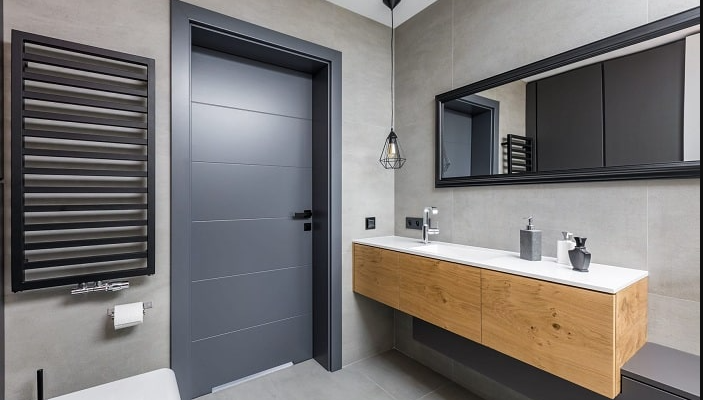Every room in our apartment needs a door. For ordinary living rooms, the choice depends only on the external characteristics of the canvas. For the door to the bathroom and toilet, beauty alone will not be enough – it must also have increased resistance to moisture.
What characteristics should a bathroom and toilet door have?
Doors to the bathroom and toilet are an integral part of the interior of the apartment. They should be combined not only with the outer part of the room, but also with the interior design: plumbing, furniture, wall and door decoration – everything should be in harmony with each other.
The most important property of a quality bathroom door is moisture resistance. Such a door without damage will endure an increased level of humidity, contact with water and steam.
If the bathroom is large, then the influence of moisture can be reduced by placing the bathtub on the opposite side of the door. With a small room size, for the same purpose, a partition can be built in front of the bathroom. But in any case, without a protective coating, ordinary doors swell and deform over time.
If the bathroom is poorly ventilated, it will signal this to you in many ways: misted mirrors and condensation on the walls and doors. To improve ventilation, you can buy a door with a ventilation grill.
To avoid the problems described, when choosing plumbing doors, you need to take into account the design and material from which they are made.
Choosing a material
Today, the construction market offers a wide range of materials and door coverings. In order not to make a mistake when choosing a quality toilet and bathroom door, you need to know the main characteristics and advantages of all types.
MDF doors
MDF is one of the most popular materials for making interior doors.
MDF sheets are made from finely dispersed wood chips, on which a coating is applied on top.
For the bathroom and toilet, it is better to choose laminated MDF doors. In this case, the MDF board is covered with a laminate – a special film that provides moisture resistance to the door.
Also, the advantages of laminated MDF doors include:
- The widest choice of door leaf designs. Here for every interior there is an “ideal” door.
- Relatively low cost.
- Environmental friendliness.
- Resistance to mechanical damage.
- Humidity resistance. Experts assure that the laminated door will withstand humidity up to 60%.
- Ease of maintenance.
Such doors also have a number of disadvantages:
- poor sound insulation;
- the impossibility of restoration in case of serious damage;
- when the coating is deformed, the door tends to accumulate moisture.
When choosing an MDF material, you should pay attention to the integrity of the coating: the presence of chips or burrs will lead to the penetration of moisture into the door structure, which will begin to deform and eventually become unusable.
Wooden doors
Solid wood doors always look aesthetically pleasing. Such door leafs create an atmosphere of wealth and luxury and fit any interior, making it more elegant. The variety of doors is great: deaf, glazed, partially glazed, decorated with mosaics.
However, for a toilet, and especially for a bathroom, wooden doors are a rather specific choice. After all, natural wood is able to “breathe”, which means it absorbs and releases moisture. Over time, the doors swell and lose their attractive appearance.
If you still prefer natural wood doors, then you should choose them correctly and take care of them:
- When buying, it is worth clarifying whether the door leaf has undergone additional processing that increases moisture resistance. The price of a processed door will increase.
- Regular painting and varnishing of the door leaf will help protect it from moisture, but this will require additional costs.
- Antiseptic treatment will also reduce the effect of water on the wood, but if the bathroom is small, this will not save your door from swelling.
Wooden doors made of beech and oak are the most resistant to moisture, so you should opt for canvases made from these types of wood. An alternative to the array may be glued laminated timber, which is more durable and resistant to temperature extremes.
In addition to low resistance to moisture, wooden doors also have such disadvantages as:
- high price;
- the severity of the structure.
But you can not get around a number of undoubted advantages that solid wood doors have:
- Increased sound insulation. Through such doors, the sound of water can not interfere with anyone.
- Eco-friendly design.
- A diverse selection of textures, shades, textures of the door leaf.
- Nobility and aesthetic appearance.
When buying doors from composite door manufacturer, carefully inspect the doors for chips, blisters, scratches and pay attention to the coating of the canvas, giving preference to natural compounds that are safe for health.
Wax, oil and lacquer coating emphasize the texture of wood and, due to its water-repellent properties, effectively protect it from moisture. Wax and oil give a slight matte sheen, and varnish gives a gloss.
Plastic doors
Doors made of plastic – an inexpensive but durable material – feel great in wet rooms, which is an important factor when choosing. To enhance the strength of the structure, deaf or glazed, plastic doors can be reinforced with a metal profile, and to increase sound insulation, the internal cavities are filled with polystyrene foam.
Plastic doors appeared not so long ago appeared on the market, but have already won “their audience”. Fans have a lot to love about them:
- have absolute resistance to water and steam;
- durable in operation;
- have good heat and sound insulation;
- not affected by mold and mildew;
- relatively inexpensive;
- easy to care for.
This option, ideal for the bathroom and toilet, still has two drawbacks:
- Plastic doors are mostly white.
- If the door does not have a metal profile, then this can cause the leaf to deform under heavy loads on it.
Plastic doors contain chloride, but all products are tested and have quality certificates.
As you can see, the disadvantages of a plastic door are significantly less than the advantages. Therefore, it will be an excellent choice for installation in a bathroom and will serve for a long time and functionally.
Glass doors
A glass door always looks non-trivial and elegant, and if it is made of tempered glass, it loses the main disadvantage of glass surfaces – fragility, so it can withstand all the necessary loads.
Glass doors have the following positive qualities:
- Moisture resistance: the material is not afraid of direct contact with water and steam.
- Good sound and thermal insulation.
- High strength: tempered glass will be difficult to break.
- Environmental friendliness: glass doors are not afraid of fungus and mold.
- Attractive design and wide range of models.
- Glass doors do not deform even after many years.
Glass products can be decorated with sandblasted patterns or mosaics, which makes the doors even more exclusive.
Glass doors also have disadvantages:
- Condensation settles on the glass surface, which leaves ugly smudges.
- Doors need regular care: in order for the glass to look neat, it must be wiped frequently.
- Glass doors are quite heavy, so they require high-quality fastening.
- Prices for glass doors can bite.
If financial costs and frequent maintenance do not scare you, then a glass door will be an excellent choice for a bathroom and will delight you with its exquisite beauty for many years.
If you have a separate bathroom, then it is better to refuse to install a completely glass door in the toilet: even frosted glass has a slight transparency.
Doors with PVC coating
Such a door is made of MDF profile, on top of which a special PVC film is applied. Such designs win over all types of doors, because they combine almost all the advantages inherent in wooden, plastic, glass and MDF doors, but at the same time they are practically devoid of disadvantages.
Choosing a door design
Doors for sanitary facilities are divided according to the method of opening. Swing doors are the most common, but there are other options. You should choose based on the characteristics of the room and your preferences.
Read More Door to Door Sales: Top Tips From Expert D2D Sellers
swing door
Familiar to the eye classic swing doors are in every home, they are considered the most stable and reliable, versatile and do not require special conditions.
Swing doors can open both to the right and to the left. The main disadvantage, relevant for small rooms, is the need for free space for the door to open freely.
sliding door
This is ideal for small spaces: sliding to the side, these doors perfectly save free space. However, they are not without drawbacks:
- lack of sound and heat insulation due to the presence of a gap under the door;
- if the door mechanism is designed in such a way that the canvas goes into the wall when opened, then if such a door breaks, it is quite difficult to repair it;
- if, when opening the door, it enters an adjacent wall, then this wall should always be free.
folding door
Folding doors, “book” and “accordion”, require the least amount of space to open. They do not go into the wall or on the wall, thereby facilitating the installation and planning of the interior next to the bathroom or bathroom.
The door-book consists of two halves, which, when opened, are connected and stand across the doorway. This feature may also be a disadvantage, reducing the width of the passage into the room.
How to make the correct measurement
Of course, there are standard sizes for plumbing doorways. In Soviet-type buildings, they are 60 * 200 cm, in new houses – 70 * 200 cm.
If you are not the first owner of the apartment or are simply not sure about the standard size of the opening, it is better to take measurements yourself.
- Remove the old door leaf and trim.
- Measure the height of the opening from the floor (if there is no finish on the floor, then take into account its future thickness) before overlapping.
- Measure the width of the opening from wall to wall.
- Measure the thickness of the wall, taking into account its future finish (if not). The resulting value is the depth of the opening.
After measuring the opening, you need to calculate the size of the door. To do this, subtract the following values:
- The distance between the wall and the box is 1–1.5 cm.
- Box beam 2.5 cm thick.
- The distance between the box and the cloth is 3 cm.
- The distance between the bottom of the box and the threshold is 1 cm.




